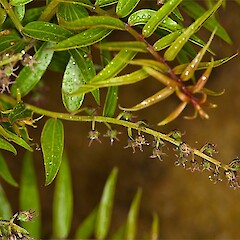Coriaria pteridoides
Common name
small-leaved tutu
Synonyms
Coriaria lurida var. acuminata Cockayne et Allan; Coriaria lurida complex sensu Allan (1961)
Family
Coriariaceae
Flora category
Vascular – Native
Endemic taxon
Yes
Endemic genus
No
Endemic family
No
Structural class
Trees & Shrubs - Dicotyledons
NVS code
The National Vegetation Survey (NVS) Databank is a physical archive and electronic databank containing records of over 94,000 vegetation survey plots - including data from over 19,000 permanent plots. NVS maintains a standard set of species code abbreviations that correspond to standard scientific plant names from the Ngä Tipu o Aotearoa - New Zealand Plants database.
CORPTE
Chromosome number
2n = 80
Current conservation status
The conservation status of all known New Zealand vascular plant taxa at the rank of species and below were reassessed in 2017 using the New Zealand Threat Classification System (NZTCS) – more information about this can be found on the NZTCS website. This report includes a statistical summary and brief notes on changes since 2012 and replaces all previous NZTCS lists for vascular plants.
Please note, threat classifications are often suggested by authors when publications fall between NZTCS assessment periods – an interim threat classification status has not been assessed by the NZTCS panel.
- Conservation status of New Zealand indigenous vascular plants, 2017 . 2018. Peter J. de Lange, Jeremy R. Rolfe, John W. Barkla, Shannel P. Courtney, Paul D. Champion, Leon R. Perrie, Sarah M. Beadel, Kerry A. Ford, Ilse Breitwieser, Ines Schönberger, Rowan Hindmarsh-Walls, Peter B. Heenan and Kate Ladley. Department of Conservation. Source: NZTCS and licensed by DOC for reuse under the Creative Commons Attribution 4.0 International licence.
2017 | Not Threatened
Previous conservation statuses
2012 | Not Threatened
2009 | Not Threatened
2004 | Not Threatened
Brief description
Low-growing bushy spreading shrub consisting of many erect branches bearing feathery dark green narrow long pointed leaves 15-25mm long by 2-4mm wide inhabiting the Volcanic Plateau and Mt Taranaki. Leaves become narrower towards tip of branches. Branches square in cross-section, soft, fuzzy.
Life cycle
Fleshy berries are dispersed by frugivory (Thorsen et al., 2009).
Etymology
coriaria: From the Latin corium ‘hide’, possibly from the use of some species for tanning leather
pteridoides: Resembling Pteridium (genus name from the Greek pteris, meaning wing or feather)
Poisonous plant
All Coriaria species are poisonous especially the seed inside the black berries. Click on this link for more information about Poisonous native plants.








